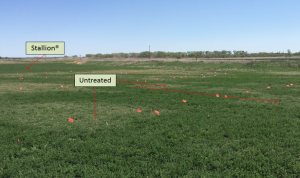—by Sharon Dobesh
For Kansas beekeepers interested in using HopGuard II for varroa mite control, the 2015 section 18 was approved effective April 13, 2015 through December 31, 2015. The active ingredient in HopGuard is 16% potassium salt of hop beta acids, which offers an alternate chemistry against varroa mites and is considered to be a more natural or ‘softer’ chemistry.
The use directions for HopGuard II in the colony at a rate of one strip per five deep frames covered with bees in each brood chamber. Strips must be opened and hung over the frame, two strips per ten frame super. There is a maximum of three applications per year per super (i.e. six strips per year super) is allowed. Application should occur based on varroa mite levels in the colony. For optimal results, little to no brood should be present in the colony.
Inspections
The Kansas Department of Agriculture needs beekeepers, who are current users of HopGuard, to volunteer for required Section 18 inspections. If you use HopGuard and would allow KDA to come inspect HopGuard use in your hive(s), please contact Judy Glass, judy.glass@kda.ks.gov. Judy will need your name and contact information to follow-up. These inspections should not take longer than an hour to complete (probably less), but are required data for EPA in order for Kansas to continue to apply for Section 18 status. All volunteers may not be inspected.
Contact Sharon Dobesh (sdobesh@ksu.edu or 785-532-1340) if you have any questions regarding the section 18 approval, need a copy of the HopGuard II label, or the KDA inspections.


